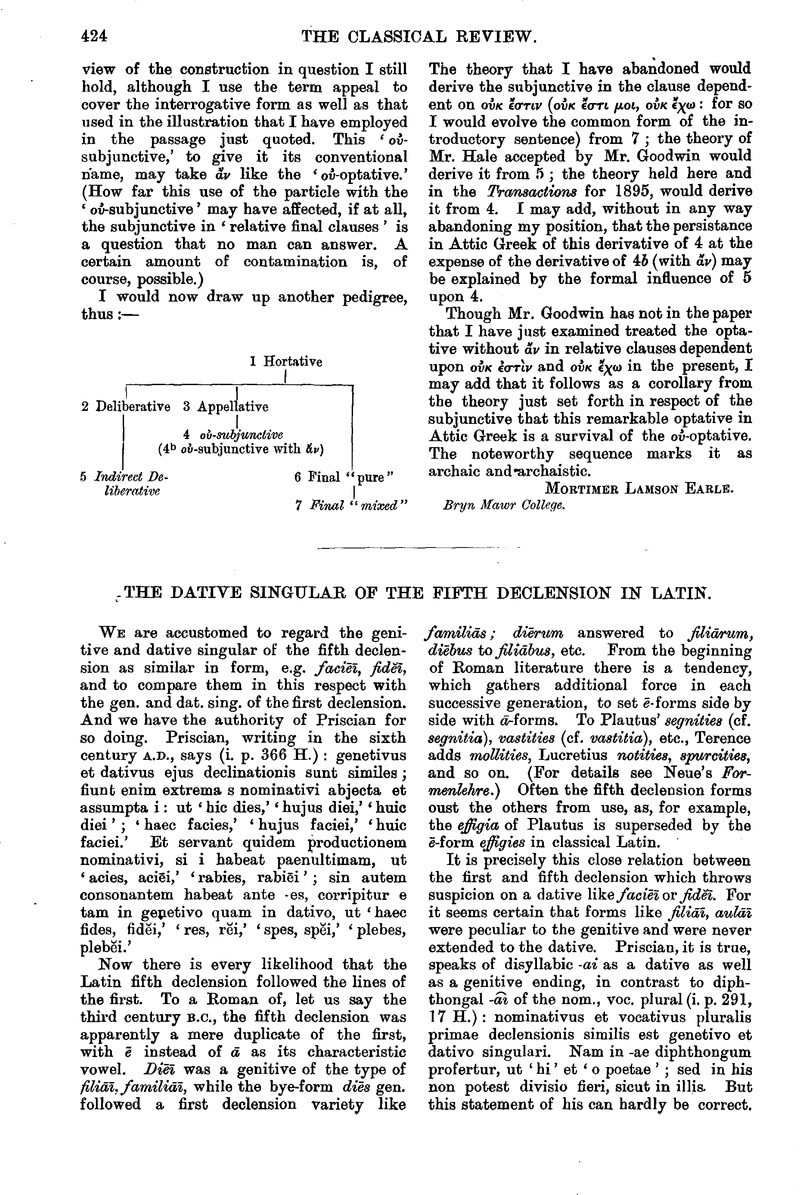No CrossRef data available.
Article contents
The Dative Singular of the Fifth Declension in Latin
Published online by Cambridge University Press: 27 October 2009
Abstract

- Type
- Review Article
- Information
- Copyright
- Copyright © The Classical Association 1896
References
page 425 note 1 Through an unfortunate confusion in the correction of the proofs this fact has been wrongly stated in my Latin Language, p. 386, ch. vi. § 25. For ‘the same as that of the genitive’ read ‘the same as that of Ā stems.'’
425 Neue (Formenlehre 2 i. p. 378) quotes fiděī dat. from Ennius (ap. Non. p. 112 M.). But the manuscripts' reading (see Onions' edition) reliquae fidei points to an archetype with reiique fidei, scanned ![]() , and gives no authority for a trisyllabic fiděī. His rěī dat. in Ter. Ad. i. 2, 16 (95) has even less justification. All the MSS. agree in presenting the line in this, the indubitably correct form:
, and gives no authority for a trisyllabic fiděī. His rěī dat. in Ter. Ad. i. 2, 16 (95) has even less justification. All the MSS. agree in presenting the line in this, the indubitably correct form:
![]() dáre operam, ruri ésse parcum ac sóbrium.
dáre operam, ruri ésse parcum ac sóbrium.
In the face of all this evidence we can hardly scan the line of Caecilius (Com. 25 R.) as: nil égo spˇī credo: ómnis res spissás facit. Ribbeck scans: nihíl ego spei credo. The variation however of the MSS. of Nonius) between n. rei ego c. (H1GZ1B) and n. e. spei c. (H2LPVZ2) may point to:
nil ![]() ego credo: ómnis res spissás facit.
ego credo: ómnis res spissás facit.
The testimony of ‘l'ubl. Syrus’ Append. 327: numquam satist spei inprobae quicquid datur, is of course of little value.
page 425 note 3 I do not think that any stress should be laid on the fact that re-s was an I.-Eur. ēy-stem with dat. sing, rēy-ai. For there is every indication that all Latin Fifth Decl. words, whatsoever may have been their I.-Eur. origin, formed their dat. sing, in one and the same way.
page 426 note 1 Seneca, be it noted, was the first to scan cui as a disyllable, cuī.
page 426 note 2 So too in an inscription like the Epist. Praet. ad Tiburtes of e. 100 B.C. (C.I.L. i. 201): neque īd uobeis neque rei poplicae uostrae oitile esse facere, the ei of rei may express the same sound as the ei of uobeis. FIDE (dat.) on an old inscription of Picenum C, I.L. i. 170) is equally ambiguous, for at this early time E often represents the diphthong ei. Cf. SALVTE for Salutei, class. Salutī, on an inscription of the same period and locality (i. 179).
426 Julius Caesar in the second book of his I Analogia declared die, specie, etc., to be the true genitive forms. We should therefore expect to find these forms in his writings. But the MSS. offer persistently the ‘modern’ ei-forms, though we have acie Bell. Gall. ii. 23, 1 (for fuller details see Neue, p. 379). This fifth decl. genitive in -ē, the existence of which is beyond doubt, seems at first sight to break the natural sequence (1) -ēī, (2) -ēī, (3) -![]() , (4)-î. But I think that the true explanation of it is that after the fourth stage had been reached (in the course of the second century B.C.), forms like progeni, speciī fell under suspicion of being second declension genitives and were reformed on the analogy of the other cases so as to end in -ē, the characteristic vowel of the fifth declension, progeniē, speciē. The evidence for a dative in -e seems stronger than that for a genitive in -e in the early literature, e.g. Plautus.
, (4)-î. But I think that the true explanation of it is that after the fourth stage had been reached (in the course of the second century B.C.), forms like progeni, speciī fell under suspicion of being second declension genitives and were reformed on the analogy of the other cases so as to end in -ē, the characteristic vowel of the fifth declension, progeniē, speciē. The evidence for a dative in -e seems stronger than that for a genitive in -e in the early literature, e.g. Plautus.


